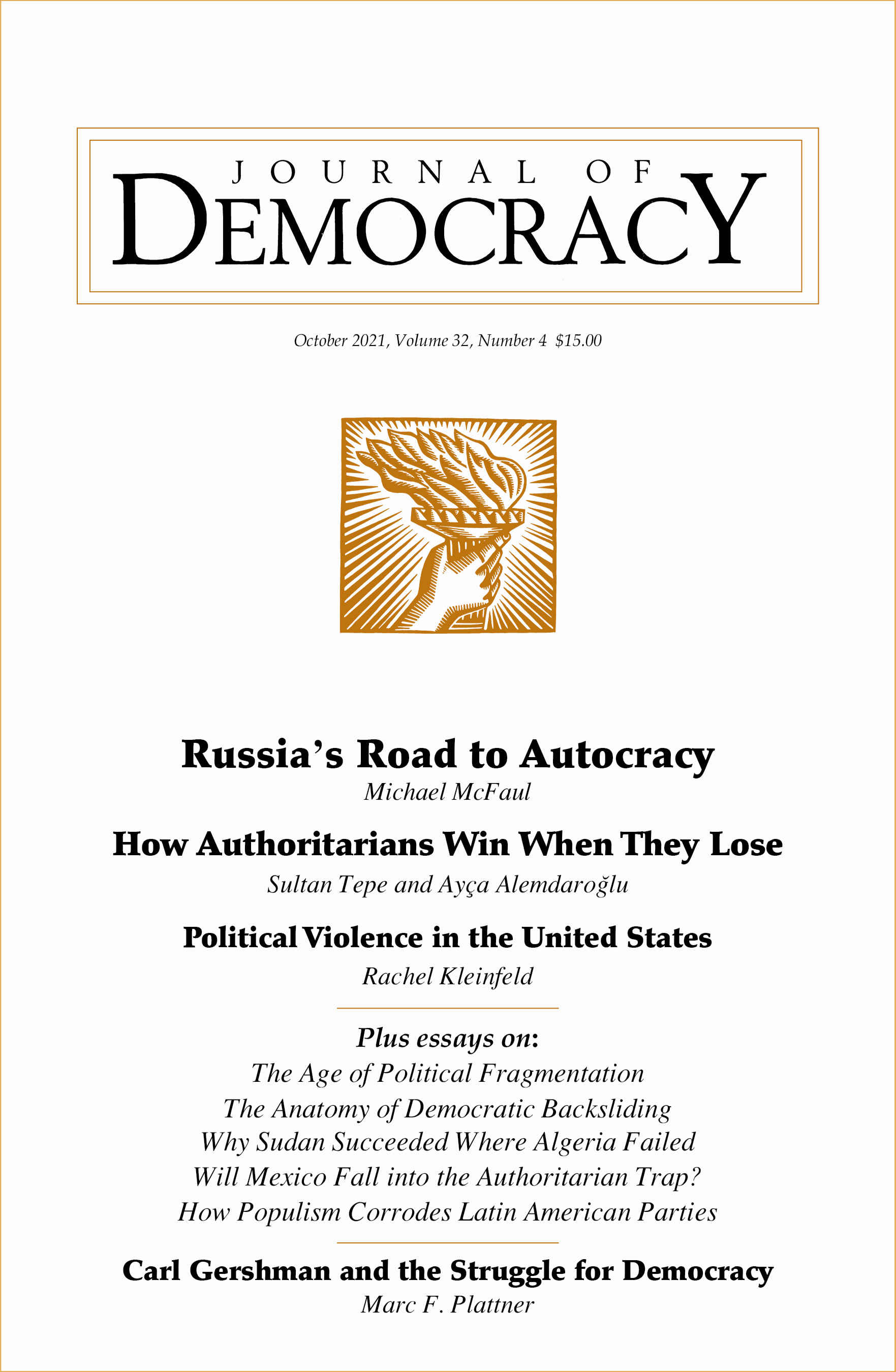 Amid declining popularity, Putin and his regime are cracking down harder than ever. But 30 years ago, with the collapse of the Soviet Union, Russia was an aspiring democracy. How did it wind up an authoritarian power all over again?
Amid declining popularity, Putin and his regime are cracking down harder than ever. But 30 years ago, with the collapse of the Soviet Union, Russia was an aspiring democracy. How did it wind up an authoritarian power all over again?
Plus: Political violence is on the rise in the United States, and the number of people who think it justified is growing; and among the many ills afflicting Western democracies is the splintering of political authority.
Read the Journal of Democracy’s October 2021 issue, available for free on Project MUSE through November 18.
- Michael McFaul, former U.S. ambassador to Russia, follows the country’s path since the collapse of Soviet rule—from fledgling democracy to Putin’s “managed democracy” to full-blown autocracy—detailing the factors and personalities that shaped its return to authoritarianism.
- Political violence in the United States is not new, but it is escalating today. Rachel Kleinfeld explains how the threats have changed and what makes the United States particularly vulnerable to more violence.
- Rick Pildes argues that political fragmentation is undermining effective government in Western democracies. As the power to make and influence policy becomes more diffuse, legislatures and political parties are becoming more dysfunctional.
Also in this issue:
- Indonesia’s President Joko Widodo has sidelined democracy for the sake of his development-first vision, argue Saiful Mujani and R. William Liddle. Can electoral democracy survive?
- Sultan Tepe and Ayça Alemdaroğlu examine the latest strategy of Turkey’s ruling party to grab power at the local level: criminalizing opposition winners, dismissing them from office, and replacing them with state-appointed trustees.
- Sharan Grewal analyzes why, after mass uprisings toppled longtime dictators in Algeria and Sudan, one country succeeded in its democratic transition while the other failed.
- Kurt Weyland explains how the strain of populism dominating Latin America today is more damaging than in the past, as the rule of charismatic leaders not only polarizes the population but also keeps opposition forces divided and political parties weak.
- Taking stock of Mexico midway through AMLO’s presidency, Mariano Sánchez-Talanquer and Kenneth Greene show how the president’s populist movement combined with Mexico’s weak and poorly performing institutions is eroding the party system and political representation.
- If democracy is so popular, why is it in so much trouble? Using survey data from 72 societies, Jie Lu and Yun-han Chu find that while publics in many democracies prioritize democratic principles, there is widespread willingness to trade them for short-term gains.
- Wouter van der Brug and his coauthors find that support for liberal-democratic norms is dangerously malleable: A Europe-wide study shows that voters are willing to shed these norms when their party is in power, especially on the far right.
- Stephan Haggard and Robert Kaufman diagram the anatomy of democratic backsliding, locating three causal factors—polarization, pliable legislatures, and piecemeal attacks on institutions—in sixteen case studies.
Plus:
- Marc F. Plattner reflects on the storied career of Carl Gershman, who stepped down as head of the National Endowment for Democracy in July after nearly four decades.
- In a review of Debasish Roy Chowdhury and John Keane’s To Kill a Democracy: India’s Passage to Despotism, Šumit Ganguly considers how governance and election issues may be hastening India’s autocratic turn.

